Research - (2021) Volume 0, Issue 0
Modeling of hybrid cultivation technology corn to ensure energy efficiency for sustainable rural development
V. Palamarchuk, I. Honcharuk, N. Telekalo*, V. Krychkovskyi, I. Kupchuk and M. MordvaniukAbstract
The research results were obtained during the scientific work. Development of the concept of energy security and energy efficiency as priority areas for sustainable development of rural areas (state registration number 0121U109443), which is carried out at the expense of the general fund of the state budget (deadline: 2021-2022). It is established that taking into account the dependence of the manifestation of economically valuable traits in maize hybrids will effectively select maize hybrids with the necessary parameters, in this case for the production of alternative energy sources and create adaptive elements of technology for their cultivation. The use of cluster analysis allows us to approach the solution of the difficult problem of increasing the efficiency of the correct selection of hybrids and elements of technology to obtain the maximum yield of bioethanol per unit area of maize hybrids. Based on the results of the cluster analysis, a dendrogram of grouping into classes was created using the single relationship method. Clustering of the studied hybrids on a set of economically valuable traits allows to draw conclusions about the recommendations for the technology of their cultivation and the creation of algorithms and mechanisms for predicting the level of productivity based on predicting the response rate of plants and their growth and development and will effectively select corn hybrids. types of energy. Studies have established the dependence of bioethanol yield on maturity groups of hybrids, their varietal characteristics, elements of technology (sowing dates, foliar fertilization and depth of seed wrapping and the size of its fraction). The yield of bioethanol in the group of early-maturing hybrids was 3,131 thousand l/ha, medium-early-3,551 thousand l/ha and medium-ripe-4,139 thousand l/ha.
Keywords
Corn, hybrid, sustainable development, mathematical model, energy security.
Introduction
Grain production in Ukraine is the basis of agriculture and a strategic sector for the state (Palamarchuk and Telekalo, 2018; Mazur et al., 2020а; Mazur et al., 2020b). Due to the favorable geographical location, favorable natural and climatic conditions in our country, there are objective prerequisites for successful cultivation of corn (Palamarchuk et al., 2018a; Palamarchuk and Kovalenko, 2018a; Palamarchuk and Kovalenko, 2018b; Palamarchuk and Kovalenko, 2019a; Palamarchuk and Kovalenko, 2019b; Palamarchuk et al., 2021).
Corn is one of the most profitable crops, which requires considerable resources in its production. It has huge potential for record grain yields. But this becomes a reality only with the cultivation technology that meets the biological characteristics of the plant and provides for adjustment of sowing dates, optimal supply of nutrients, the use of the latest hybrids and quality seeds (Palamarchuk, 2018a; Palamarchuk, 2018b; Palamarchuk and Telekalo, 2021).
Bioethanol is traditionally made by fermenting corn kernels, sugar cane and beet molasses. Various statements of domestic and foreign scientists on certain issues of technologies for growing and processing corn for bioethanol, confirm the relevance and need for further research on this issue, so work in this direction is quite relevant and promising (Kaletnik et al., 2019; Kaletnik et al., 2020a; Kaletnik et al., 2020b; Kaletnik et al., 2020c).
The use of biofuels and other renewable energy sources is considered and discussed primarily in the context of environmental protection and the desire; Kupchuk et al., 2020; Telekalo and Melnyk, 2020e; Honcharuk et al., 2021; Telekalo and Mordvanyuk, 2021).
In Europe, the main sources of raw mate to guarantee conditions for sustainable regional and local development (Kupchuk et al., 2018; Didur et al., 2020a; Didur et al., 2020b rials for bioethanol are sugar beets, wheat and corn, their total yield, sugar and starch content, as well as the yield of alcohol determine the suitability of these crops for bioethanol production. In the United States, about 40% of the corn crop is processed to produce corn ethanol (Palamarchuk et al., 2009; Palamarchuk et al., 2010; Palamarchuk et al., 2011; Palamarchuk et al., 2012; Palamarchuk et al., 2013; Palamarchuk et al., 2015; Telekalo, 2017a; Telekalo, 2017b; Palamarchuk et al., 2018c; Palamarchuk et al., 2018d; Polishchuk et al., 2018; Telekalo, 2018a; Telekalo, 2018a; Palamarchuk et al., 2019; Telekalo and Blah et al., 2019; Telekalo, 2019a; Telekalo, 2019b; Telekalo and Melnyk, 2020c; Telekalo and Melnyk, 2020d; Telekalo and Blah et al., 2020).
Currently, the increase in the yield of corn hybrids can be achieved, namely, by increasing the mass of corn from the cob, particularly taking into account the laying of generative organs and elements of the harvest structure in the early stages of plant development (5-9 leaves), where the competitive relationship between them is not represented so brightly. Applying foliar fertilizers during this period will allow to optimize the processes of formation of generative organs in maize plants, so research in this area is relevant and promising. Yield is the result of the relationship of plants to terrestrial and cosmic factors (Mazur et al., 2017a; Mazur et al., 2017b; Telekalo and Blah et al., 2017; Mazur et al., 2018; Telekalo et al., 2019; Mazur et al., 2020a; Mazur et al., 2020b; Mazur et al., 2021;). It shows how effective or ineffective a particular element of technology has turned out to be. The number of rows of grains, the number of cobs per plant, the size of the cob, the number of grains per row, the weight of 1000 grains, the yield of grains from a cob and the number of plants per area unit are the elements of corn yield structure (Yanovich, et al., 2017; Yanovich, et al., 2018; Telekalo and Melnyk, 2020a; Telekalo and Melnyk, 2020b; Tkachuk and Telekalo, 2020). The number of rows of grains is a genetically determined feature and does not have a noticeable effect on plant productivity, since any change can be compensated, both by the indicator of "number of grains in a row" and by their weight. The number of rows per cob is usually constant until the number of plants per m2 exceeds about 14.
Materials and Methods
Field research was carried out during on the research field of the Department of Plant Cultivation, Breeding and Bioenergy Crops of Vinnytsia National Agrarian University of Ukraine under conditions of the right-bank Forest-Steppe. Field experiments were carried out in accordance with the guidelines presented in the Methodology of Field Experiments in Corn (Tandzi and Mutengwa, 2020; Tucker et al., 2020). Hybrids of domestic selection (Kharkivskyi 195MV and Pereiaslavskyi 230SV) and hybrids of Monsanto Company DKC 2870, DKC 2960, DKC 2949, DKC 2787, DKC 2971, DKC 3476, DKC 3795, DKC 3472, DKC 3420, DKC 391, DKC 3871, DKC 3511, DK 440, DKC 4964, DKC 4626, DK 315 were used as the most productive ones of three groups of maturity, including early, mid-early and mid hybrids. An ecological-and-genetic model of quantitative traits was used to study the phenotypic productivity of corn hybrids and to establish the influence on the trait formation. The model is constructed on the basis of the hierarchy of manifestation of the productivity traits in ontogenesis and the correspondence of their manifestation in organogenesis. Since the stages of implementation of the quantitative trait in the phenotype reflect the stages of complication of the genetic system, the relationship between the components of the model can be considered as an indicator of the dynamic order of interaction between the elements of the genetic system.
Results and Discussion
In medium-ripe hybrids, the regularity of clustering differs somewhat from the features we have found characteristic of early-ripening and middle-early hybrids. In fact, in this group of maturity, the biological features of the studied hybrids determined to a large extent the peculiarities of the formation of a set of economically valuable traits, rather than the features of individual studied elements of cultivation technology. We believe that this is due in part to a longer growing season, which eliminates the delay in growth and development of plants at the beginning of the growing season.
Thus, according to the results of the analysis, it was found that the first cluster includes all variants of growing the hybrid DK 315 except for the variant of growing with a fine fraction of seeds and the depth of seed wrapping 10-11 cm. The second cluster includes variants of growing the hybrid DKC 4082 with the exception of variants with growing a small fraction of seeds and wrapping depths of 4-5 and 10-11 cm, respectively. On the other hand, the clear distribution of clusters by varietal characteristics indicates a good adaptive potential of hybrids DK 315 and DKC 4082. In fact, changes in the technology of growing these hybrids can be offset by plants in the process of their growth and development. Therefore, these hybrids forgive quite serious mistakes in cultivation technology, such as too deep sowing of seeds. Accordingly, the analysis of clustering features of the studied hybrids by a set of economically valuable traits allows to draw conclusions about the recommendations for the technology of their cultivation and the creation of algorithms and mechanisms for predicting productivity based on predicting the response rate of plants and their growth and development. Data on clustering of early-maturing maize hybrids by a set of economically valuable traits, for the study of foliar fertilization and the number of their use are presented in Fig. 1.
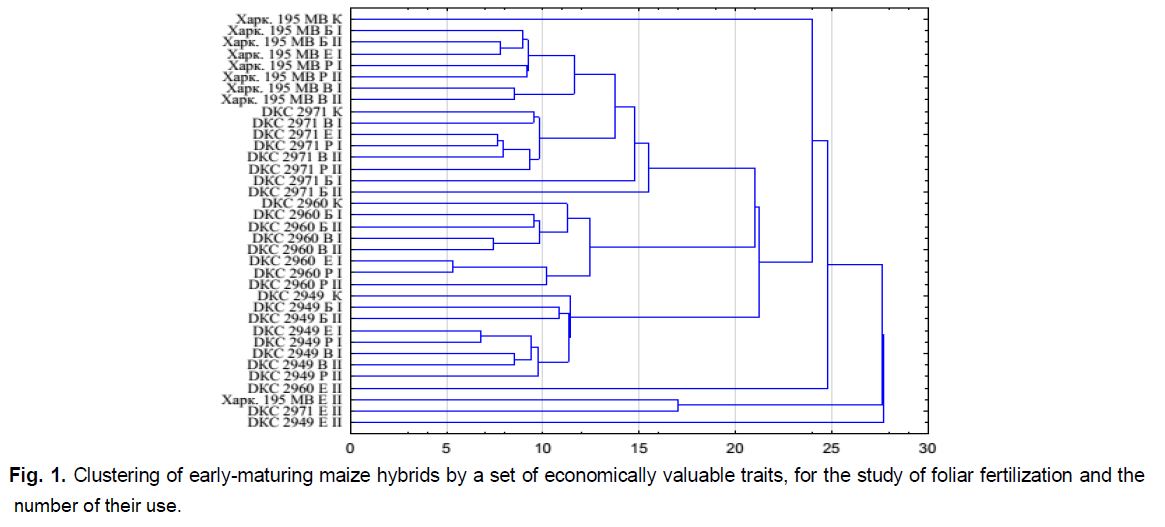
Figure 1: Clustering of early-maturing maize hybrids by a set of economically valuable traits, for the study of foliar fertilization and the number of their use.
Four clusters can be distinguished for the use of different variants of foliar fertilization and their different number on the studied hybrids. In fact, the clusters are formed by plants of the same hybrid and only in the case of Ecolist Mono Zinc with twice the number of feedings, all hybrids differ quite seriously in the set of economically valuable traits from similar feedings by other drugs. Indicators of clustering of medium-early hybrids of maize by a set of economically valuable traits, for the study of foliar fertilization and the number of their use are presented in Fig. 2.
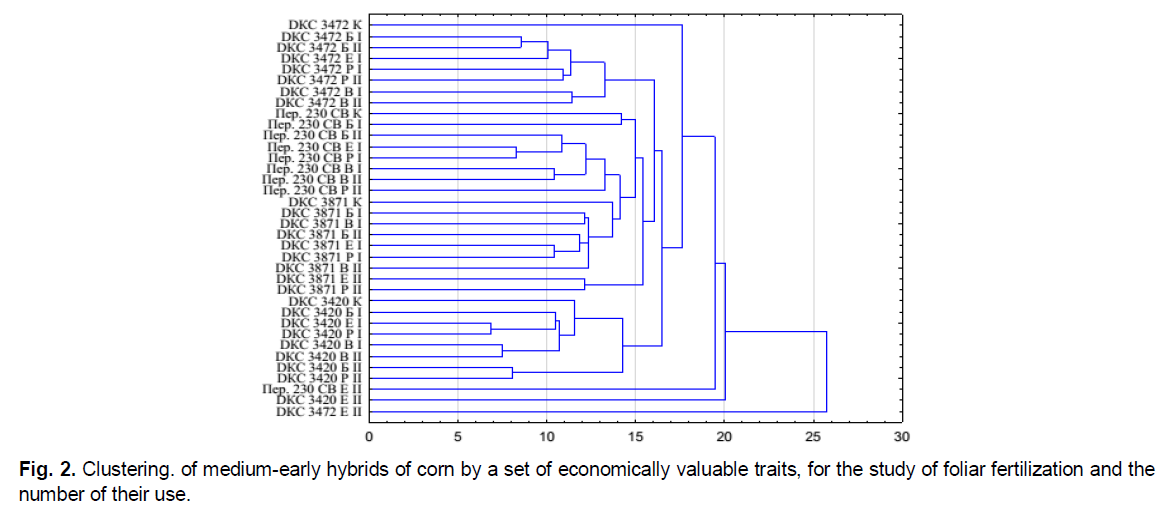
Figure 2: Clustering of medium-early hybrids of corn by a set of economically valuable traits, for the study of foliar fertilization and the number of their use.
Similarly to the norm of reaction of early-ripening hybrids in middle-early ones, there is also a grouping into clusters primarily according to the affiliation of the variants of the experiment to which hybrid is grown. Thus, the first cluster includes all variants of studying different foliar fertilizers and their number in the hybrid DKC 3472.
The second cluster includes variants of the experiment presented by hybrids Pereyaslavsky 230 SV and DKS 3871, which may indicate a certain similarity of these hybrids and their response rates for a set of economically valuable traits. Therefore, the cultivation of such hybrids on the farm as a safeguard against the effects of adverse growing conditions and the expansion of the adaptive potential of the culture is unacceptable, as in fact they respond equally to the factors of agrocenosis.
The third cluster, by analogy with the previous two, includes all options for the application of foliar feeding with different number of treatments in areas of the hybrid DKS 3420.
And only hybrids Pereyaslavsky 230 SV, DKS 3420 and DKS 3472 with double processing Ecolist Mono Zinc are removed from all presented clusters.
The image parameters of the clustering of medium-ripe hybrids of corn by a set of economically valuable features, for the study of foliar fertilization and the number of their use are given in Fig. 3.
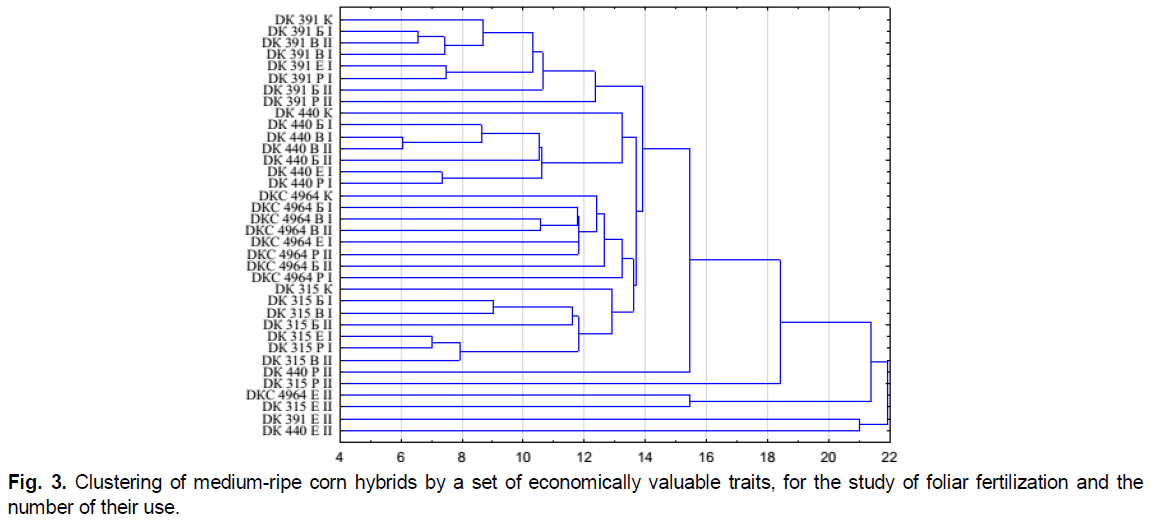
Figure 3: Clustering of medium-ripe corn hybrids by a set of economically valuable traits, for the study of foliar fertilization and the number of their use.
By analogy with other groups of maturity, the studied hybrids were clustered by a set of economically valuable traits, respectively, into four groups of clusters. The first group of clusters includes all variants of foliar feeding of the hybrid DK 391, and the second cluster DK 440. The third cluster includes variants of the experiment for growing a hybrid of corn DKS 4964 and the fourth - DK 315. Outside the defined groups of clusters are hybrids DK 440 and DK 315 for double foliar feeding Rostok corn and DK440, DK 391, DK 315 and DKC 4964 for double foliar feeding Ecolist Mono Zinc. Consequently, these options for the use of foliar fertilization can eliminate the adaptive capacity of plants within a single hybrid to form a set of economically valuable traits. The model of influence of weather conditions on the duration of interphase periods of early corn hybrids is graphical represented in Fig. 4.
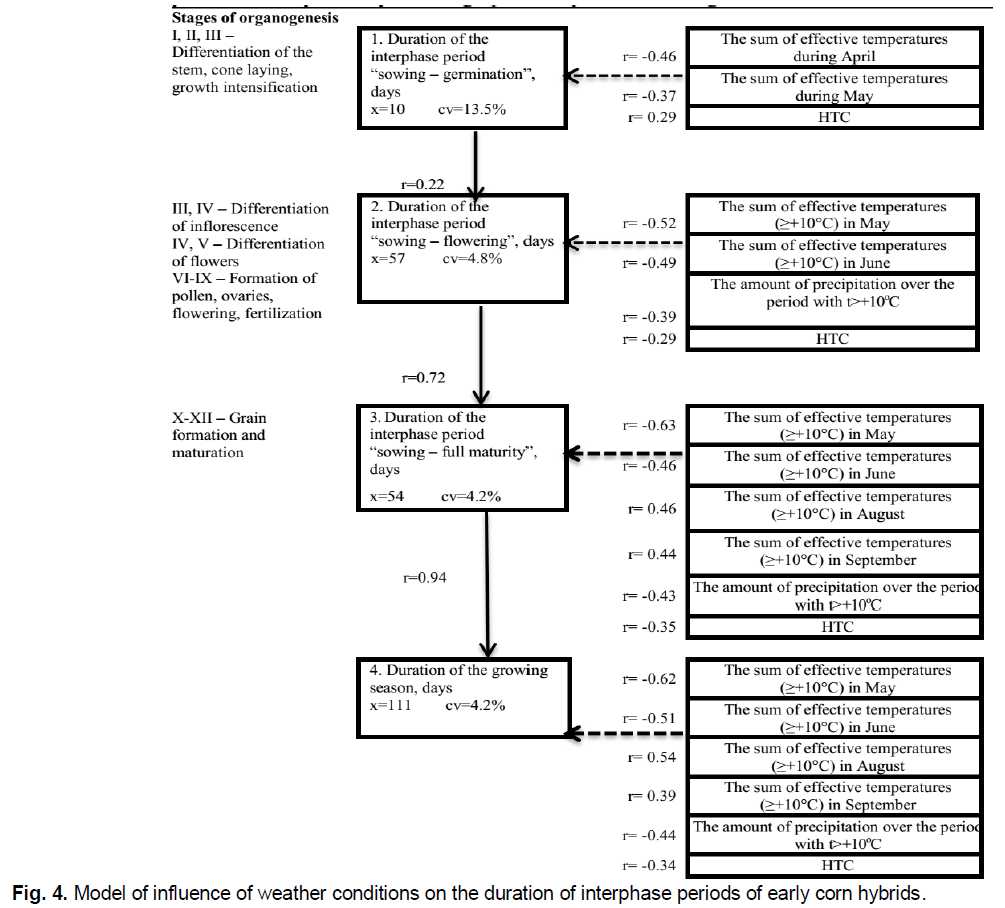
Figure 4: Model of influence of weather conditions on the duration of interphase periods of early corn hybrids.
The sum of effective temperatures (≥ +10°C) in April and the sum of effective temperatures (≥ +10°C) in May had the highest influence on the duration of this interphase period, and the correlation coefficient was r=-0.46 and r=-0.37, respectively. In fact, the obtained results indicate that under the increase in the amount of effective temperatures during the period of sowing-germination, its duration in plants reduces. The formation of this feature was also influenced by the hydrothermal coefficient (HTC), and the correlation coefficient was r=0.29. In fact, the increase in the hydrothermal coefficient in spring is directly related to the increase in the amount of precipitation, and therefore it had a positive effect on the germination rate of early corn hybrids.
Interphase period germination-flowering on average in the experiment lasted for 57 days under a low level of trait variation. However, despite this, both the sum of effective temperatures and the amount of precipitation and HTC had a significant effect on the duration of the period. The sum of effective temperatures (≥ +10°C) in May and the sum of effective temperatures (≥ +10°C) in June had traditionally high correlation coefficients at the level of moderate and significant correlation of r=-0.52 and r=-0.49, respectively. At this stage, there is a critical period of growth and development of corn plants concerning the demand for moisture supply.
Therefore, the amount of precipitation also significantly affected the duration of the interphase period «germination-flowering and the correlation coefficient was r=-0.39. Under the absence of precipitation, corn plants slowed down their growth and development, and therefore the duration of the phase increased. Similarly, this is confirmed by the importance of the effect of HTC at the level of r=-0.29. Interphase period flowering-full maturity on average in the experiment lasted for 54 days under a low level of trait variation. However, despite this, the duration of the period was greatly influenced by the sum of effective temperatures, amount of precipitation and HTC.
First of all, there should be noted an indirect effect of the sum of effective temperatures (≥ +10°C) in May and the sum of effective temperatures (≥ +10°C) in June with r=-0.63 and r=-0.46, respectively. In fact, the plants received the rate of heat supply at earlier stages of growth and development, in particular, before the interphase period flowering-full maturity, however, the impact of these factors on further plant growth and development is quite significant. The sums of effective temperatures (≥ +10°C) in August and the sums of effective temperatures (≥ +10°C) in September were important factors in the formation of duration of the interphase period flowering-full maturity.
However, in contrast to the previous interphase period, they were positively correlated and correlation coefficients were r=0.46 and r=0.44, respectively. In fact, a direct correlation between the traits studied means that the increase in sum of active temperatures in early corn hybrids results in the accelerated grain establishment and formation and reduction of the duration of this interphase period. At this stage, there is also a critical period of growth and development of corn plants concerning the demand for moisture supply. Thus, the amount of precipitation also significantly affected the duration of interphase period and correlation coefficient was r=-0.43, and the effect of HTC was at the level of r=-0.35.
Total duration of the growing season of early corn hybrids was 111 days under insufficient trait variation. The duration of the growing season was influenced by the sum of effective temperatures, the amount of precipitation and HTC.
The sum of effective temperatures (≥ +10°C) in May and the sum of effective temperatures (≥ +10°C) in June had correlation coefficients at the level of r=-0.62 and r=-0.51, respectively. While the sum of effective temperatures (≥ +10°C) in August and the sum of effective temperatures (≥ +10°C) in September had r=0.59 and r=0.39, respectively. The amount of precipitation also significantly affected the duration of the growing season and correlation coefficient was r=-0.44, and the effect of HTC was at the level of r=-0.34.
A graphical representation of the model of the influence of weather conditions on the duration of interphase periods of mid-early corn hybrids is shown in Fig. 2.
The duration of the interphase period sowing-germination in mid-early corn hybrids on average in the experiment was 10 days with an average level of trait variation.
The sum of effective temperatures and HTC had a significant influence on the formation of the duration of this period. Similarly to the hybrids of early group for the studied mid-early corn hybrids, the sum of effective temperatures (≥ +10°C) in April and the sum of effective temperatures (≥ +10°C) in May had an important influence on the duration of the first interphase period and correlation coefficient was -0.51 and r=-0.52, respectively. However, HTC had insufficient effect on the duration of this period, the correlation coefficient was r=0.17.
The duration of the next interphase period germination-flowering in mid-early corn hybrids on average in the experiment was 65 days under a low level of trait variation. The sum of effective temperatures, the amount of precipitation and HTC had a significant influence on the formation of the duration of this period.
It was found that the duration of the period was influenced by the sum of effective temperatures (≥ +10°C) in May and the sum of effective temperatures (≥ +10°C) in June under the level of correlation coefficients of r=-0.23 and r=-0.28, respectively. The amount of precipitation affected at the level of strong correlation r=-0.71 and HTC - r=0.21.
In general according to the experiment, interphase period flowering-full maturity of mid-early corn hybrids, lasted for 60 days, and the studied trait varied slightly. Trait formation was influenced by the sum of effective temperatures, the amount of precipitation and HTC.
Similarly to early corn hybrids, mid-early hybrids are also indirectly affected by the sum of effective temperatures (≥ +10°C) in May and the sum of effective temperatures (≥ +10°C) in June with r=-0.39 and r=-0, 18, respectively, and the duration of the interphase period flowering-full maturity is also affected by the sum of effective temperatures (≥ +10°C) in August and the sum of effective temperatures (≥ +10°C) in September with r=0.15 and r=0.28.
In addition, the duration of the period germination-flowering in mid-early corn hybrids is influenced by the amount of precipitation r=-0.23 and hydrothermal coefficient r=-0.20.
Total duration of the growing season of mid-early corn hybrids was 125 days with weak trait variation (Fig. 5).
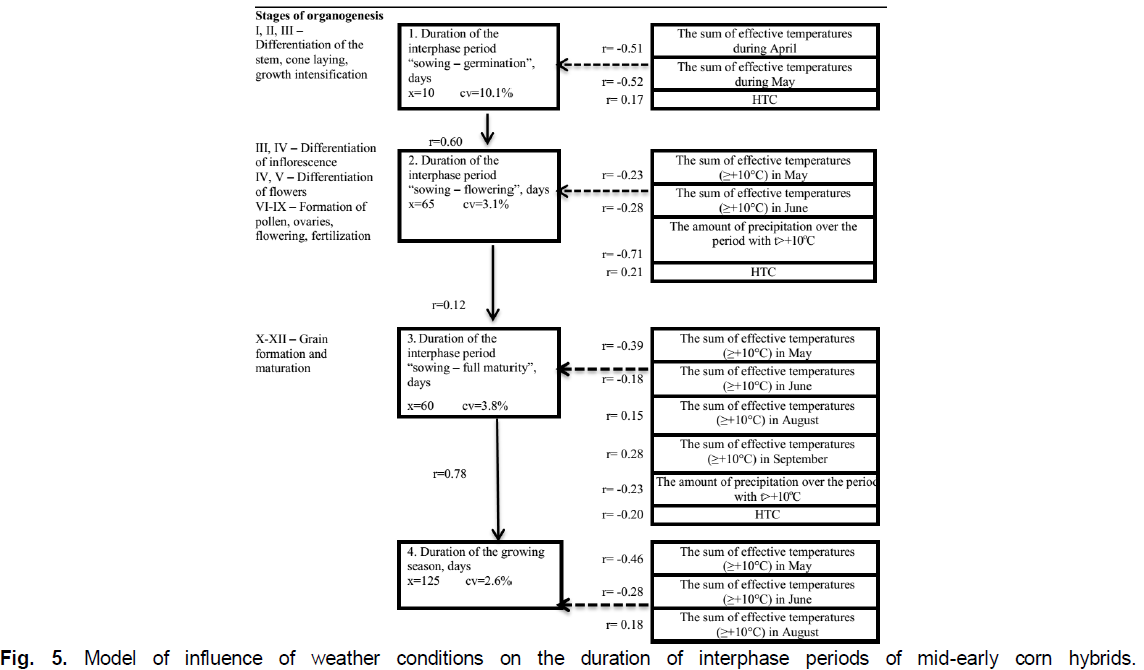
Figure 5: Model of influence of weather conditions on the duration of interphase periods of mid-early corn hybrids.
The duration of the growing season was generally influenced by the sum of effective temperatures. The sum of effective temperatures (≥ +10°C) in May and the sum of effective temperatures (≥ +10°C) in June had correlation coefficients at the level of r=-0.46 and r=-0.28, respectively, and the sum of effective temperatures (≥ +10°C) in August had r=0.18. Thus, the growth and development of mid-early corn hybrids are influenced by all environmental factors, but the most significant influence is performed by the sum of effective temperatures.
The model of the influence of weather conditions on the duration of interphase periods of early-corn hybrids is represented graphically in Fig. 6.
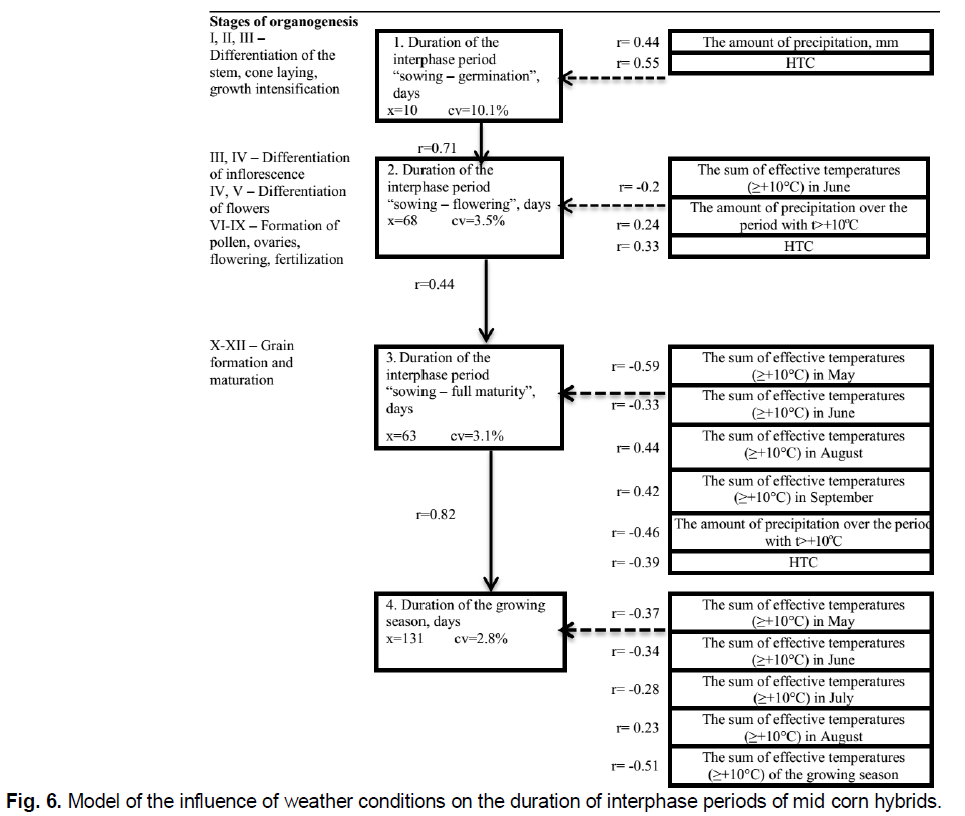
Figure 6: Model of the influence of weather conditions on the duration of interphase periods of mid corn hybrids.
Interphase period sowing-germination in mid corn hybrids on average in the experiment lasts for 10 days under an average level of trait variation. The amount of precipitation and HTC significantly affect the formation of its duration.
It is established that in contrast to early and mid-early corn hybrids, the duration of this interphase period in mid corn hybrids was significantly influenced by the amount of precipitation with r=0.44 and HTC - r=0.55. Interphase period germination-flowering in mid corn hybrids on average in the experiment lasts for 68 days under a low level of trait variation. The sum of effective temperatures, amount of precipitation and HTC had a significant influence on the formation of the duration of this period.
It is determined that the duration of the period is influenced by the sum of effective temperatures (≥ +10°C) in June under the level of correlation coefficient r=-0.25 and the sum of precipitation under the level of r=0.24, and HTC - r=0.33. It is investigated that the interphase period flowering-full maturity» of mid corn hybrids in the experiment lasted for 63 days, and the studied trait varied insufficiently. Trait formation was influenced by the sum of effective temperatures, amount of precipitation and HTC.
Duration of the interphase period flowering-full maturity is determined by the additive effect of the sums of effective air temperatures. Thus, an inherent indirect effect is performed by the sum of effective temperatures (≥ +10°C) in May and the sum of effective temperatures (≥ +10°C) in June with r=-0.59 and r=-0.33, respectively, as well as the sum effective temperatures (≥ +10°C) in August and the sum of effective temperatures (≥ +10°C) in September with r=0.44 and r=0.42.
In addition, it can be argued that the duration of the studied period in mid corn hybrids is influenced by the amount of precipitation with r=-0.46, and hydrothermal coefficient - r=-0.39. It is found that the total duration of the growing season of mid corn hybrids was 131 days under weak trait variation. The duration of the growing season was generally influenced by the sum of the effective temperatures of the corn growing season.
It is established that the growth and development of early corn hybrids are influenced by all environmental factors, but the most significant influence is performed by the sum of effective temperatures. Thus, the sum of effective temperatures (≥ +10°C) in May, June and July had correlation coefficients at the level of r=-0.37, r=-0.34 and r=-0.28, respectively, and the sum of effective temperatures (≥ +10°C) in August under r=0.18. There can also be observed the influence of the total amount of effective temperatures (≥ +10°C) during the growing season under the level of correlation coefficient of r=-0.51.
Conclusion
The yield of bioethanol per unit area of maize hybrids also depended on the seed fraction and the depth of its wrapping. ha and medium-ripe -4.13 thousand l/ha. The obtained mathematical models of the vegetation period duration of maize hybrids allowed to determine that the sums of effective temperatures (≥ +10°C) for May, June, August and September at correlation coefficients at the level of r=- 0.62 and r=-0.51 have the greatest influence, r=0.59 and r=0.39, respectively. Also, the amount of precipitation significantly affected the duration of the growing season and the correlation coefficient was r=-0.44, and the effect of HTC was at the level of r=-0.34. Analyzing the differences between the groups of early and medium-early maize hybrids, in general, their growth and development are influenced to a relative extent by the amount of effective temperatures, precipitation and HTC. It is proved that medium-ripe hybrids react somewhat differently to environmental factors, which allows to develop elements of adaptive cultivation technology for each of the maturity groups. The analysis determined that for hybrids of these groups of maturity the same regularities of the basic indicators under the influence of which productivity of corn is formed, including depending on weather conditions remain.
References
Didur, I., Bakhmat, M., Chynchyk, O., Pantsyreva, H., Telekalo, N., Tkachuk, O. (2020a). Substantiation of agroecological factors on soybean agrophytocenoses by analysis of variance of the Right-Bank Forest-Steppe in Ukraine. Ukrainian Journal of Ecology, 10:54-60.
Didur, I., Pantsyreva, H., Telekalo, N. (2020b). Agroecological rationale of technological methods of growing legumes. The Scientific Heritage, 52:3-14.
Honcharuk, I., Kupchuk, I., Solona, O., Tokarchuk, O., Telekalo, N. (2021). Experimental research of oscillation parameters of vibrating-rotor crusher. Przeglad Elektrotechniczny, 97:97-100.
Kaletnik, H., Pryshliak, V., Pryshliak, N. (2019). Public policy and biofuels: Energy, environment and food trilemma. Journal of Environmental Management and Tourism, 3:479-487.
Kaletnik, H., Honcharuk, I., Okhota, Yu. (2020a). The waste-free production development for the energy autonomy formation of ukrainian agricultural enterprises. Journal of Environmental Management and Tourism, 43:513-522.
Kaletnik, H., Honcharuk, I., Yemchyk, T., Okhota, Y. (2020b). The worldexperience inthe regulation ofthe land circulation. European Journal of Sustainable Development, 9:557-568.
Kaletnik, H., Ivanovs, S., Bulgakov, V., Kuvachоv, V., Shymko, L., Ihnatiev, Y. (2020c). Experimental checking of mathematical models describing the functioning adequacy of bridge systems in agricultural track system. INMATEH-Agricultural Engineering, 3:107-114.
Kupchuk, I.M., Solona, O.V., Derevenko, I.A., Tverdokhlib, I.V. (2018). Verification of the mathematical model of the energy consumption drive for vibrating disc crusher. INMATEH -Agricultural Engineering, 55:111-118.
Kupchuk, I.M., Yaropud, V.M., Telekalo, N.V., Granyak, V.F. (2020). Prospects and prerequisites for the introduction of autonomous power supply systems of agro-industrial enterprises. Machinery, Energy, Transport of Agro-Industrial Complex, 3:51-63.
Mazur, O.V., Kolisnyk, O.M., Telekalo, N.V. (2017a). Genotypic differences in varieties of common beans by manufacturability. Agriculture and Forestry, 7:33-39.
Mazur, V., Didur, I., Myalkovsky, R., Pantsyreva, H., Telekalo N., Tkach, O. (2020a). The productivity of intensive pea varieties depending on the seeds treatment and foliar fertilizing under conditions of right-bank forest-steppe Ukraine. Ukrainian Journal of Ecology, 10:101-105.
Mazur, V., Didur, I., Pantsyreva, G., Telekalo, N. (2018). Energy-economic efficiency of growth of grain-crop cultures in conditions of right-bank forest-steppe zone of Ukraine. Ukrainian Journal of Ecology, 8:26-33.
Mazur, V.A., Honcharuk, I.V., Didur, I.M., Pantsyreva, H.V., Telekalo, N.V., Kupchuk, I.M. (2021). Innovative aspects of technologies for growing, storage and processing of legumes: a monograph. Vinnytsia: Nilan-LTD, p:180.
Mazur, V.A., Honcharuk, I.V., Pantsyreva, H.V., Telekalo, N.V. (2020b). Agroecological substantiation of technological methods of growing legumes: monograph. Vinnytsia: Works, p:192.
Mazur, V.A., Palamarchuk, V.D., Polishchuk, I.S., Palamarchuk, O.D. (2017b). The latest agricultural technologies in crop production. Vinnytsia, p:588.
Mazur, V.A., Polishchuk, I.S., Telekalo, N.V., Mordvanyuk, M.O. (2020a). Plant growing. Part II: textbook. Vinnytsia: Druk Publishing House, p:284.
Mazur, V.A., Polishchuk, I.S., Telekalo, N.V., Mordvanyuk, M.O. (2020b). Plant growing. Part I: textbook. Vinnytsia: Druk Publishing House, p:352.
Palamarchuk, V., Telekalo, N. (2018). The effect of seed size and seeding depth on the components of maize yield structure. Bulgarian Journal of Agricultural Science, 24:785-792.
Palamarchuk, V., Honcharuk, I., Honcharuk, T., Telekalo, N. (2018a). Effect of the elements of corn cultivation technology on bioethanol production under conditions of the right-bank forest-steppe of Ukraine. Ukrainian Journal of Ecology, 8:42-50.
Palamarchuk, V., Krychkovskyi, V., Honcharuk, I., Telekalo, N. (2021). The Modeling of the production process of high-starch corn hybrids of different maturity groups. European Journal of Sustainable Development, 10:584-598.
Palamarchuk, V.D., Kovalenko, O.A. (2018a). Formation of height of laying of cobs at hybrids of corn depending on terms of sowing. Taurian Scientific Bulletin, 100:26-33.
Palamarchuk, V.D., Kovalenko, O.A. (2018b). Influence of foliar fertilization on the formation of the leaf surface area of maize hybrids. Bulletin of Agrarian Science of the Black Sea Coast, 2:32-38.
Palamarchuk, V.D., Kovalenko, O.A. (2019a). Duration of separate interphase and vegetation periods of maize hybrids depending on sowing dates. Taurian Scientific Bulletin, 106:119-127.
Palamarchuk, V.D., Kovalenko, O.A. (2019b). Influence of foliar fertilization on the area of cob leaves in corn. Agriculture and Forestry, 9:68-78.
Palamarchuk, V.D., Telekalo, N.V. (2021). Prospects for growing corn for grain to produce bioethanol. Agriculture and Forestry, 21:47-61.
Palamarchuk, V.D. (2018a). Influence of foliar fertilization on the resistance of maize hybrids to lodging. Agriculture and Forestry, 8:14-25.
Palamarchuk, V.D. (2018b). Influence of foliar fertilization on the number of cobs in maize hybrids. Bulletin of Agricultural Science, 8:24-32.
Palamarchuk, V.D. (2018c). Influence of sowing dates on the leaf surface area of maize hybrids of different maturity groups. Bulletin of Lviv National Agrarian University, 22:290-299.
Palamarchuk, V.D. (2018d). Influence of wrapping depth and seed fraction on starch content in corn grain and bioethanol yield. Bulletin of the Poltava State Agrarian Academy, 2:55-65.
Palamarchuk, V.D., Kalenskaya, S.M., Ermakova, L.M., Polishchuk, I.S., Polishchuk, M.I. (2015). Systems of modern intensive technologies in crop production. Vinnytsia: FOP Rogalska IO, p:452.
Palamarchuk, V.D., Klimchuk, O.V., Polishchuk, I.S., Kolisnyk, O.M., Borivsky, A.F. (2010). Ecological-biological and technological principles of production of field crops. Vinnytsia: FOP Danyliuk, p:636.
Palamarchuk, V.D., Mazur, V.A., Zozulya, O.L. (2009). Corn. Selection and cultivation of hybrids. Monograph. Vinnytsia, p:199.
Palamarchuk, V.D., Palamarchuk, O.D., Volchanskaya, I.V., Melnik, V.V. (2019). Influence of elements of cultivation technology on grain corn productivity. Collection of Scientific Works of VNAU, 1:75-80.
Palamarchuk, V.D., Polishchuk, I.S., Venediktov, O.M. (2011). Systems of modern intensive technologies in crop production. Vinnytsia: FOP Danyliuk, p:432.
Palamarchuk, V.D., Polishchuk, I.S., Ermakova, L.M., Kalenskaya, S.M. (2012). Systems of modern intensive technologies (2nd edition of corrections and additions). Vinnytsia: FOP Rogalska IO, p:370.
Palamarchuk, V.D., Polishchuk, I.S., Ermakova, L.M., Kalenskaya, S.M. (2013). Biology and ecology of agricultural plants. Vinnytsia: FOP Danyliuk, p:636.
Polishchuk, I.S., Telekalo, N.V. (2018). Formation of productivity of spring barley varieties depending on the influence of foliar fertilization in the conditions of the Forest-Steppe of the Right Bank. Agriculture and Forestry, 8:35-44.
Telekalo, N., Melnyk, M. (2020a). Agroecological substantiation of medicago sativa cultivation technology. Agronomy Research, 18:2613-2626.
Telekalo, N., Mordvaniuk, M., Shafer, H., Matsera, O. (2019). Agroecological methods of improving the productivity of niche leguminous crops. Ukrainian Journal of Ecology, 9:169-175.
Telekalo, N.V., Blah, M.V. (2020). Influence of elements of cultivation technology on productivity of alfalfa sowing in the conditions of the Forest-steppe of the right bank. Agriculture and Forestry, 6:35-43.
Telekalo, N.V., Blah, M.V. (2017). Biological nitrogen as a guarantee of ecological safety of soils. Agriculture and Forestry, 5:155-164.
Telekalo, N.V., Melnik, M.V. (2019). Ways to increase the productivity of alfalfa for sowing seeds. Agriculture and Forestry, 15:56-63.
Telekalo, N.V., Melnik, M.V. (2020b). Fodder productivity of alfalfa sowing depending on agroecological methods of cultivation. Agroecological Journal, 2:76-83.
Telekalo, N.V., Melnik, M.V. (2020c). Improving agroecological methods of growing alfalfa. Agriculture and Forestry, 16:73-88.
Telekalo, N.V., Melnik, M.V. (2020d). Seed productivity of alfalfa sown depending on the elements of cultivation technology. Scientific Reports of NULES of Ukraine.
Telekalo, N.V., Melnyk, M.V. (2020e). Feed productivity of medicago sativa depending on the elements of growing technology. Colloquium-Journal, 13:18-20.
Telekalo, N.V., Mordvanyuk, M.O. (2021). Influence of elements of technology on accumulation of biological nitrogen by crops of peas. Agriculture and Forestry, 21:62-68.
Telekalo, N.V. (2017a). Influence of technological methods of pea cultivation on soil nitrogen supply. Agriculture and Forestry, 6:97-102.
Telekalo, N.V. (2017b). The influence of environmental factors on the growth and development of intensive varieties of peas. Agriculture and Forestry, 5:241-247.
Telekalo, N.V. (2018a). Agroecological methods of cultivation (pisum sativum) in the forest-steppe conditions of the right bank. Agriculture and Forestry, 9:79-88.
Telekalo, N.V. (2018b). The productivity of intensive pea varieties depending on the seeds treatment and foliar fertilizing under conditions of right-bank forest-steppe. Agriculture and Forestry, 11:114-122.
Telekalo, N.V. (2019a). Influence of a complex of technological methods on growing peas. Agriculture and Forestry, 13:84-93.
Telekalo, N.V. (2019b). The effectiveness of bacterial preparations in the cultivation of peas. Agriculture and Forestry, 14:127-140.
Tkachuk, O., Telekalo, N. (2020). Agroecological potential of legumes in conditions of intensive agriculture of Ukraine collective monograph. Latvia: Riga: Baltija Publishing, pp:91-104.
Yanovich, V., Honcharuk, T., Honcharuk, I., Kovalova K. (2018). Engineering management of vibrating machines for targeted mechanical activation of premix components. INMATEH-Agricultural Engineering, 54:25-32.
Yanovich, V., Honcharuk, T., Honcharuk, I., Kovalova, K. (2017). Design of system to control a vibratory machine for mixing loose materials. Eastern-European Journal of Enterprise Technologies, 6:4-13.
Author Info
V. Palamarchuk, I. Honcharuk, N. Telekalo*, V. Krychkovskyi, I. Kupchuk and M. MordvaniukCitation: Palamarchuk, V., Honcharuk, I., Telekalo, N., Krychkovskyi, V., Kupchuk, I., Mordvaniuk, M. (2021). Modeling of hybrid cultivation technology corn to ensure energy efficiency for sustainable rural development. Ukrainian Journal of Ecology 11 (7), 204-211.
Received: 23-Aug-2021 Accepted: 28-Sep-2021 Published: 30-Sep-2021
Copyright: This is an open access article distributed under the terms of the Creative Commons Attribution License, which permits unrestricted use, distribution, and reproduction in any medium, provided the original work is properly cited.
